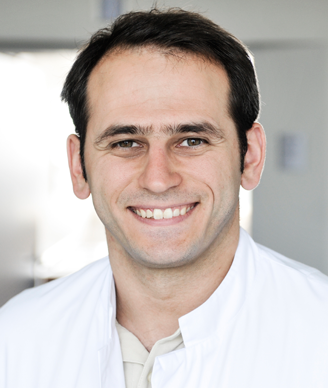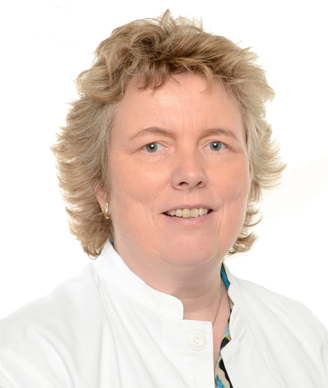Multigene Testing to Forgo Chemotherapy in Early Breast Cancer
In this interview we discuss results of the PlanB trial, which showed that use of the 21-gene recurrence score, Oncotype DX, can identify patients with early breast cancer who likely do not need chemotherapy.
Oleg Gluz, MD

Nadia Harbeck, MD, PhD

The recently published phase III PlanB trial from the West German Study Group showed that the 21-gene recurrence score, better known as Oncotype DX, is able to identify patients with early breast cancer who are likely to not need chemotherapy-these patients had the same 5-year survival after diagnosis as patients who received systemic treatment.
The study is among the first trials to provide prospective data on the utility of the 21-gene recurrence score. Today we are speaking with two of the study authors, Oleg Gluz, MD, one of the two scientific coordinators of the West German Study Group, and Nadia Harbeck, MD, PhD, head of breast center at the University of Munich, about the results and implications of the study.
- Interviewed by Anna Azvolinsky
Cancer Network: Dr. Gluz, could you first describe what the 21-gene recurrence score is and how it is currently utilized in the United States and Europe?
Dr. Gluz: The 21-gene recurrence score is one of the available genomic tools for identification of patients with relapse risk of hormone receptor–positive, HER2-negative early breast cancer. This is a continuous score, measured on the basis of 21 genes. The score is from 0–100, and if the score varies between 0–11, patients are at low risk of recurrence. The intermediate-risk group have a recurrence score between 12–25, and the high-risk group have a recurrence score of more than 25.
The use of the recurrence score is currently recommended, for example, in the United States for all patients with node-negative disease and also in some countries like Israel and Great Britain for some patients with node-negative disease. In Germany, the recurrence score is recommended to be used only for patients with an uncertain recommendation for cancer therapy.
Cancer Network: Dr. Gluz, could you briefly describe the design of the phase III study that you conducted as well as the outcomes?
Dr. Gluz: The PlanB trial was a chemotherapy trial which was planned to be performed in patients with clinically high-risk disease who were all candidates for adjuvant chemotherapy and had HER2-negative early breast cancer. After an early amendment to the trial, we performed the 21-gene recurrence score, or Oncotype DX, in all patients with HER2-negative, hormone receptor-positive disease, and all patients who had up to three positive lymph nodes and very low recurrence scores, values between 0–11. All these patients we recommended to omit randomization to chemotherapy and to be treated with endocrine therapy alone, according to the national guideline.
This is different from other trials, because in our trial we had all patients as clinically high-risk disease, and we recommended the omission of chemotherapy in cases of very low genomic risk but with node-positive disease (with one to three positive lymph nodes). All patients with more than four positive lymph nodes, all patients with triple-negative disease (HER2-negative and hormone receptor–negative disease), and all patients with a recurrence score of more than 12 were recommended to be treated with chemotherapy in this phase III study.
Cancer Network: Dr. Harbeck, what are the implications of this study in your mind?
Dr. Harbeck: I think the implications are very clear, and I think they are valid both in Europe and the United States because the treatment the patients received in our German trial is very similar to what they would have received in the United States. The study shows that patients with intermediate- to high-risk clinical disease, with node-negative disease and node-positive disease up to three lymph nodes, hormone receptor–positive, HER2-negative with a low-risk recurrence score under the cut-off score of 12, so up to 11, can be sure that they will not need any adjuvant chemotherapy because their risk of recurrence is very low. This is now confirmed by a prospective clinical trial. I think this is a very clear implication.
And we also know that the patients in the intermediate-risk group with chemotherapy also have an excellent 5-year outcome, but here obviously the question is which patients can be spared chemotherapy. But we can also assure intermediate-risk patients that they also have excellent outcomes if they had chemotherapy.
Cancer Network: How do these results relate to the recently published TAILORx study, which was also a prospective validation of the Oncotype DX score.
Dr. Harbeck: I think the results nicely complement the TAILORx study. TAILORx was also a study on hormone receptor–positive, HER2-negative, node-negative breast cancer and our PlanB study includes node-negative and node-positive patients, and we did the Oncotype testing to three involved lymph nodes and were able to avoid chemotherapy in patients with a low-risk Oncotype DX score. So in that sense, PlanB extends the TAILORx study and both of these studies are prospective validations of Oncotype DX. So far Oncotype DX is the first and only multigene assay with two prospective clinical trials backing up the test in the low-risk patients in order to avoid chemotherapy.
Cancer Network: What are the questions that remain about the usefulness and accuracy of this multigene test?
Dr. Harbeck: I think the data is very clear for the low-risk group, now. The only clinical question is that the commercially available test, at least for the node-negative patients includes patients with a recurrent score up to 18, and in the TAILORx as well as the PlanB study, the cut-off point for the score was 11. So there is a remaining uncertainty for the patients who have a score between 11–18, but I think that longer follow-up will give us more data on these groups, both from TAILORx and PlanB, even though these will be exploratory analyses. And the second question that is remaining, and that will be answered by the TAILORx study with the primary endpoint of the trial, is what to do with the intermediate-risk patients.
And as I said before, in the PlanB study, they have an excellent outcome with chemotherapy so probably, a lot of these patients could be spared chemotherapy, and they would still have an excellent outcome. In Germany, we have the ADAPT trial in the same patient collective where we add a 3 week brief endocrine treatment period before the surgery. Intermediate-risk patients with a drop in Ki67 after 3 weeks of pre-operative endocrine therapy will also be spared adjuvant chemotherapy. And I think both TAILORx as well as ADAPT will solve the problems we still have with the intermediate-risk patients.
Cancer Network: Thank you both so much for joining us today.
Dr. Harbeck: You are quite welcome.
Dr. Gluz: Thank you.